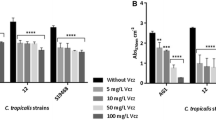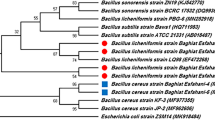Abstract
In the present investigation, we have evaluated the antibiofilm potential of Bacillus licheniformis SV1 derived glycolipid against C. glabrata biofilm. Impact of isolated glycolipid on the viability of C. glabrata and on inhibiting as well as eradicating ability of its biofilm were studied. Further, morphological alterations, reactive oxygen species generation (ROS) production and transcriptional expression of selected genes (RT-PCR) of C. glabrata in response with isolated glycolipid were studied. The isolated glycolipid (1.0 mg ml−1) inhibited and eradicated C. glabrata biofilm approximately 80% and 60%, respectively. FE-SEM images revealed glycolipid exposure results in architectural alteration and eradication of C. glabrata biofilm and ROS generation. Transcriptional studies of selected genes showed that the expression of AUS1, FKS1 and KRE1 were down-regulated, while that of ergosterol biosynthesis pathway and multidrug transporter increased, in the presence of glycolipid.





Similar content being viewed by others
Abbreviations
- PI:
-
Propidium iodide
- DCFDA:
-
2′,7′-Dichlorodihydrofluorescein diacetate
- XTT:
-
2,3-Bis(2-methoxy-4-nitro-5-sulfophenyl)-2H-tetrazolium-5-carboxanilide sodium salt
- ROS:
-
Reactive oxygen species
- FE-SEM:
-
Field emission scanning electron microscopy
- PBS:
-
Phosphate buffer saline
- YPD:
-
Yeast peptone dextrose broth medium
- FBS:
-
Foetal bovine serum
- RPMI:
-
Roswell park memorial institute 1640 medium
- TLC:
-
Thin-layer chromatography
- HPLC:
-
High-performance liquid chromatography
- FTIR:
-
Fourier transform infrared microscopy
- GC-MS:
-
Gas chromatography–Mass spectroscopy
- NMR:
-
Nuclear magnetic resonance
- MTP:
-
Microtitre plate
- BEC80 :
-
Biofilm inhibitory concentration
- BEC60 :
-
Biofilm eradicating concentration
References
Delaloye J, Calandra T (2014) Invasive candidiasis as a cause of sepsis in the critically ill patient. Virulence 5:161–169
Lohse MB, Gulati M, Craik CS, Johnson AD, Nobile CJ (2020) Combination of antifungal drugs and protease inhibitors prevent Candida albicans biofilm formation and disrupt mature biofilms. Front Microbiol 11:1027
Gupta P, Gupta S, Sharma M, Kumar N, Pruthi V, Poluri KM (2018) Effectiveness of phytoactive molecules on transcriptional expression, biofilm matrix, and cell wall components of Candida glabrata and its clinical isolates. ACS Omega 3:12201–12214
Pappas PG, Lionakis MS, Arendrup MC, Ostrosky-Zeichner L, Kullberg BJ (2018) Invasive candidiasis. Nat Rev Dis Primers 4:18026
Mean M, Marchetti O, Calandra T (2008) Bench-to-bedside review: Candida infections in the intensive care unit. Crit Care 12:204
Fu J, Ding Y, Wei B et al (2017) Epidemiology of Candida albicans and non-C.albicans of neonatal candidemia at a tertiary care hospital in western China. BMC Infect Dis 17:329
CDC. Antibiotic Resistance Threats in the United States (2019) Atlanta, GA: U.S. Department of Health and Human Services, CDC
Guinea J (2014) Global trends in the distribution of Candida species causing candidemia. Clin Microbiol Infect 20:5–10
Kumar K, Askari F, Sahu MS, Kaur R (2019) Candida glabrata: a lot more than meets the eye. Microorganisms 7:1–22
Brunke S, Hube B (2013) Two unlike cousins: Candida albicans and C. glabrata infection strategies. Cell Microbiol 15(5):701–708
Mitchell KF, Zarnowski R, Andes DR (2016) Fungal super glue: the biofilm matrix and its composition, assembly, and functions. PLoS Pathog 12(9):e1005828
Kaur R, Margaret RD, PCormack LB (2005) A yeast by any other name: Candida glabrata and its interaction with the host. Curr Opin Microbiol 8:378–384
Kuhn DM, Vyas VK (2012) The Candida glabrata adhesin Epa1p causes adhesion, phagocytosis, and cytokine secretion by innate immune cells. FEMS Yeast Res 12:398–414
Gupta P, Chanda R, Rai N, Kataria VK, Kumar N (2016) Antihypertensive, amlodipine besilate inhibits growth and biofilm of human fungal pathogen Candida. Assay Drug Dev Technol 14:291–297
Fraser M, Borman AM, Thorn R, Lawrance LM (2020) Resistance to echinocandin antifungal agents in the United Kingdom in clinical isolates of Candida glabrata: fifteen years of interpretation and assessment. Med Mycol 58:219–226
Sampaio P, Pais C (2014) Epidemiology of invasive candidiasis and challenges for the mycology laboratory: specificities of Candida glabrata. Curr Clin Microbiol Rep 1:1–9
Haque F, Alfatah M, Ganesan K, Bhattacharyya MS (2016) Inhibitory effect of sophorolipid on Candida albicans biofilm formation and hyphal growth. Sci Rep 6:23575
Gupta S, Varshney R, Jha RK, Pruthi PA, Roy P, Pruthi V (2017) In vitro apoptosis induction in human prostate cancer cell line by thermotolerant glycolipid from Bacillus licheniformis SV1. J Surfact Deterg 20:1141–1151
Marchant R, Banat IM (2012) Biosurfactants: a sustainable replacement for chemical surfactants? Biotechnol Lett 34:1597–1605
Janek T, Lukaszewicz M, Krasowska A (2012) Antiadhesive activity of the biosurfactant pseudofactin II secreted by the Arctic bacterium Pseudomonas fluorescens BD5. BMC Microbiol 12:24
Pasternak G, Askitosari TD, Rosenbaum MA (2020) Biosurfactants and synthetic surfactants in bioelectrochemical systems: a mini-review. Front Microbiol. https://doi.org/10.3389/fmicb.2020.00358
Płaza G, Achal V (2020) Biosurfactants: eco-friendly and innovative biocides against biocorrosion. Int J Mol Sci 21:2152
Gupta S, Raghuwanshi N, Varshney R, Banat IM, Srivastava AK, Pruthi P, Pruthi V (2017) Accelerated in vivo wound healing evaluation of microbial glycolipid containing ointment as a transdermal substitute. Biomed Pharmacother 94:1186–1196
Banat IM, Satpute SK, Cameotra SS, Patil R, Nyayanit NV (2014) Cost effective technologies and renewable substrates for biosurfactants production. Front Microbiol 5:1–18
Araujo LV, Guimaraes CR, Marquita RLS, Santiago VMJ, Souza MP, Nitschke M, Freire DMG (2016) Rhamnolipid and surfactin: anti-adhesion/antibiofilm and antimicrobial effects. Food Control 63:171–178
Dusane DH, Nancharaiah YV, Zinjarde SS, Venugopalan VP (2010) Rhamnolipid mediated disruption of marine Bacillus pumilus biofilms. Colloids Surf B Biointerfaces 81:242–248
Inès M, Dhouha G (2015) Glycolipid biosurfactants: potential related biomedical and biotechnological applications. Carbohydr Res 416:59–69
Gupta P, Nath S, Meena RC, Kumar N (2014) Comparative effects of hypoxia and hypoxia mimetic cobalt chloride on in vitro adhesion, biofilm formation and susceptibility to amphotericin B of Candida glabrata. J Mycol Médicale/J Med Mycol 24:e169–e177
Gupta P, Pruthi V, Poluri KM (2021) Mechanistic Insights into Candida biofilm eradication potential of eucalyptol. J Appl Microbiol. https://doi.org/10.1111/jam.14940
Pemmaraju SC, Kumar P, Pruthi PA, Prasad R, Pruthi V (2016) Impact of oxidative and osmotic stresses on Candida albicans biofilm formation. Biofouling 32:897–909
Uppuluri P, Chaturvedi AK, Srinivasan A, Banerjee M, Ramasubramaniam AK, Kohler JR, Kadosh D, Lopez-Ribot JL (2010) Dispersion an important step in the Candida albicans biofilm development cycle. PLoS ONE 6:e1000828
Krcmery V, Kalavsky E (2007) Antifungal drug discovery, six new molecules patented after 10 years of feast: why do we need new patented drugs apart from new strategies? Recent Pat Antiinfect Drug Discov 2:182–187
Warn PA, Sharp A, Guinea J, Denning DW (2004) Effect of hypoxic conditions on in vitro susceptibility testing of amphotericin B, itraconazole and micafungin against Aspergillus and Candida. J Antimicrob Chemother 53:743–749
Tareq FS, Seung H, Yeon L, Lee J, Seok J, Shin HJ (2015) Ieodoglucomide C and Ieodoglycolipid, new glycolipids from a marine-derived bacterium Bacillus licheniformis 09IDYM23. Lipids 50:513–519
Mani P, Dineshkumar G, Jayaseelan T, Deepalakshmi K, Kumar GC, Balan SS (2016) Antimicrobial activities of a promising glycolipid biosurfactant from a novel marine Staphylococcus saprophyticus SBPS 15. 3 Biotech 6:163
Biniarz P, Baranowska JF, Krasowska A (2015) The lipopeptides pseudofactin II and surfactin effectively decrease Candida albicans adhesion and hydrophobicity. Antonie Van Leeuwenhoek 108:343–353
Gavella M, Kveder M, Lipovac V (2010) Modulation of ROS production in human leukocytes by ganglioside micelles. Braz J Med Biol Res 43:942–949
Cury-Boaventura MF, Curi R (2005) Regulation of reactive oxygen species (ROS) production by C18 fatty acids in Jurkat and Raji cells. Clin Sci 108:245–253
Aranda A, Sequedo L, Tolosa L, Quintas G, Burello E, Castell JV, Gombau L (2013) Dichloro-dihydro-fluorescein diacetate (DCFH-DA) assay: a quantitative method for oxidative stress assessment of nanoparticle-treated cells. Toxicol Vitro 27:954–963
Singh N, Pemmaraju SC, Pruthi PA, Cameotra SS, Pruthi V (2013) Candida biofilm disrupting ability of di-rhamnolipid (RL-2) produced from pseudomonas aeruginosa DSVP20. Appl Biochem Biotechnol 169:2374–2391
Kiran GS, Sabarathnam B, Selvin J (2010) Biofilm disruption potential of a glycolipid biosurfactant from marine Brevibacteriumcasei. FEMS Immunol Med Microbiol 59:432–436
Singh P, Cameotra SS (2004) Potential applications of microbial surfactants in biomedical sciences. Trends Biotechnol 22:142–146
Elshikh M, Funston S, Chebbi A, Ahmed S, Marchant R, Banat IM (2017) Rhamnolipids from non-pathogenic Bukholderiahailandensis E264: physicological characterization, antimicrobial and antibiofilm efficacy against oral hygine related pathogens. New Biotechnol 36:26–36
Acknowledgements
SG is extremely thankful to the Department of Science and Technology, INSPIRE (DST, INSPIRE) Govt. of India (Grant No. IF130678) for providing financial support. PG acknowledges DBT-RAship, Department of Biotechnology, Govt. of India. The authors are also thankful to Institute Instrumentation Centre (IIC), IIT Roorkee and Department of Chemical Engineering, IIT Roorkee for providing the instrumentation facility.
Author information
Authors and Affiliations
Contributions
SG and PG designed and performed the experiments under the supervision of VP. PG critically analysed the experimental data. SG wrote and revised the important intellectual content of the manuscript with the help of PG and VP along with the final approval of the version to be submitted for the publication.
Corresponding author
Ethics declarations
Conflict of interest
The authors declare no conflict of interest.
Additional information
Publisher's Note
Springer Nature remains neutral with regard to jurisdictional claims in published maps and institutional affiliations.
Supplementary Information
Below is the link to the electronic supplementary material.
Rights and permissions
About this article
Cite this article
Gupta, S., Gupta, P. & Pruthi, V. Impact of Bacillus licheniformis SV1 Derived Glycolipid on Candida glabrata Biofilm. Curr Microbiol 78, 1813–1822 (2021). https://doi.org/10.1007/s00284-021-02461-5
Received:
Accepted:
Published:
Issue Date:
DOI: https://doi.org/10.1007/s00284-021-02461-5




